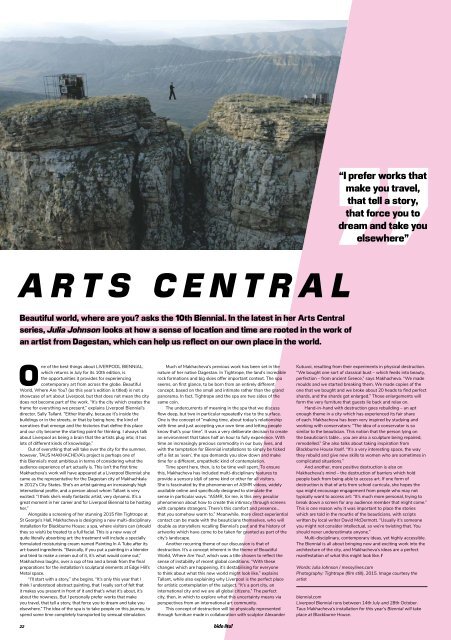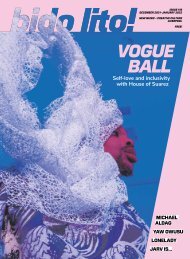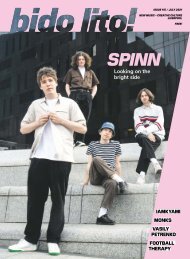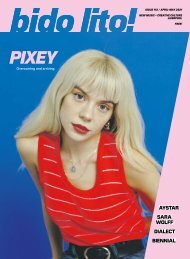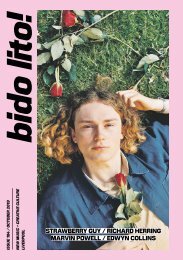Issue 90 / July 2018
July 2018 issue of Bido Lito! magazine. Featuring: MC NELSON, THE DSM IV, GRIME OF THE EARTH, EMEL MATHLOUTHI, REMY JUDE, LIVERPOOL BIENNIAL, CAR SEAT HEADREST, THE MYSTERINES, TATE @ 30 and much more.
July 2018 issue of Bido Lito! magazine. Featuring: MC NELSON, THE DSM IV, GRIME OF THE EARTH, EMEL MATHLOUTHI, REMY JUDE, LIVERPOOL BIENNIAL, CAR SEAT HEADREST, THE MYSTERINES, TATE @ 30 and much more.
Create successful ePaper yourself
Turn your PDF publications into a flip-book with our unique Google optimized e-Paper software.
“I prefer works that<br />
make you travel,<br />
that tell a story,<br />
that force you to<br />
dream and take you<br />
elsewhere”<br />
ARTS CENTRAL<br />
Beautiful world, where are you? asks the 10th Biennial. In the latest in her Arts Central<br />
series, Julia Johnson looks at how a sense of location and time are rooted in the work of<br />
an artist from Dagestan, which can help us reflect on our own place in the world.<br />
One of the best things about LIVERPOOL BIENNIAL,<br />
which returns in <strong>July</strong> for its 10th edition, is<br />
the opportunities it provides for experiencing<br />
contemporary art from across the globe. Beautiful<br />
World, Where Are You? (as this year’s edition is titled) is not a<br />
showcase of art about Liverpool, but that does not mean the city<br />
does not become part of the work. “It’s the city which creates the<br />
frame for everything we present,” explains Liverpool Biennial’s<br />
director, Sally Tallant. “Either literally, because it’s inside the<br />
buildings or in the streets, or that by being here, the kind of<br />
narratives that emerge and the histories that define this place<br />
and our city become the starting point for thinking. I always talk<br />
about Liverpool as being a brain that the artists plug into; it has<br />
lots of different kinds of knowledge.”<br />
Out of everything that will take over the city for the summer,<br />
however, TAUS MAKHACHEVA’s project is perhaps one of<br />
this Biennial’s most ambitious in terms of considering what the<br />
audience experience of art actually is. This isn’t the first time<br />
Makhacheva’s work will have appeared at a Liverpool Biennial: she<br />
came as the representative for the Dagestan city of Makhachkala<br />
in 2012’s City States. She’s an artist gaining an increasingly high<br />
international profile, and a person about whom Tallant is very<br />
excited: “I think she’s really fantastic artist, very dynamic. It’s a<br />
great moment in her career and for Liverpool Biennial to be hosting<br />
her.”<br />
Alongside a screening of her stunning 2015 film Tightrope at<br />
St George’s Hall, Makhacheva is designing a new multi-disciplinary<br />
installation for Blackburne House: a spa, where visitors can (should<br />
they so wish) be treated to a full facial. This is a new way of<br />
quite literally absorbing art: the treatment will include a specially<br />
formulated moisturising cream named Painting In A Tube after its<br />
art-based ingredients. “Basically, if you put a painting in a blender<br />
and tried to make a cream out of it, it’s what would come out,”<br />
Makhacheva laughs, over a cup of tea and a break from the final<br />
preparations for the installation’s sculptural elements at Edge Hill’s<br />
Metal space.<br />
“I’ll start with a story,” she begins. “It’s only this year that I<br />
think I understood abstract painting, that I really sort of felt that<br />
it makes you present in front of it and that’s what it’s about, it’s<br />
about the nowness. But I personally prefer works that make<br />
you travel, that tell a story, that force you to dream and take you<br />
elsewhere.” The idea of the spa is to take people on this journey, to<br />
spend some time completely transported by sensual stimulation.<br />
Much of Makhacheva’s previous work has been set in the<br />
nature of her native Dagestan. In Tightrope, the land’s incredible<br />
rock formations and big skies offer important context. The spa<br />
seems, on first glance, to be born from an entirely different<br />
concept, based on the small and intimate rather than the grand<br />
panorama. In fact, Tightrope and the spa are two sides of the<br />
same coin.<br />
The undercurrents of meaning in the spa that we discuss<br />
flow deep, but two in particular repeatedly rise to the surface.<br />
One is the concept of “making time, about today’s relationship<br />
with time and just accepting your own time and letting people<br />
know that’s your time”. It was a very deliberate decision to create<br />
an environment that takes half an hour to fully experience. With<br />
time an increasingly precious commodity in our busy lives, and<br />
with the temptation for Biennial installations to simply be ticked<br />
off a list as ‘seen’, the spa demands you slow down and make<br />
time for a different, empathetic kind of contemplation.<br />
Time spent here, then, is to be time well spent. To ensure<br />
this, Makhacheva has included multi-disciplinary features to<br />
provide a sensory idyll of some kind or other for all visitors.<br />
She is fascinated by the phenomenon of ASMR videos, widely<br />
available online and specifically designed to stimulate the<br />
sense in particular ways. “ASMR, for me, is this very peculiar<br />
phenomenon about how to create this intimacy through screens<br />
with complete strangers. There’s this comfort and presence...<br />
that you somehow warm to.” Meanwhile, more direct experiential<br />
contact can be made with the beauticians themselves, who will<br />
double as storytellers recalling Biennial’s past and the history of<br />
artworks which have come to be taken for granted as part of the<br />
city’s landscape.<br />
Another recurring theme of our discussion is that of<br />
destruction. It’s a concept inherent in the theme of Beautiful<br />
World, Where Are You?, which was a title chosen to reflect the<br />
sense of instability of recent global conditions. “With these<br />
changes which are happening, it’s destabilising for everyone<br />
to think about what this new world might look like,” explains<br />
Tallant, while also explaining why Liverpool is the perfect place<br />
for artistic contemplation of the subject. “It’s a port city, an<br />
international city and we are all global citizens.” The perfect<br />
city, then, in which to explore what this uncertainty means via<br />
perspectives from an international art community.<br />
This concept of destruction will be physically represented<br />
through furniture made in collaboration with sculptor Alexander<br />
Kutuvoi, resulting from their experiments in physical destruction.<br />
“We bought one sort of classical bust – which feeds into beauty,<br />
perfection – from ancient Greece,” says Makhacheva. “We made<br />
moulds and we started breaking them. We made copies of the<br />
one that we bought and we broke about 20 heads to find perfect<br />
shards, and the shards got enlarged.” Those enlargements will<br />
form the very furniture that guests lie back and relax on.<br />
Hand-in-hand with destruction goes rebuilding – an apt<br />
enough theme in a city which has experienced its fair share<br />
of each. Makhacheva has been very inspired by studying and<br />
working with conservators: “The idea of a conservator is so<br />
similar to the beautician. This notion that the person lying on<br />
the beautician’s table... you are also a sculpture being repaired,<br />
remodelled.” She also talks about taking inspiration from<br />
Blackburne House itself. “It’s a very interesting space, the way<br />
they rebuild and give new skills to women who are sometimes in<br />
complicated situations.”<br />
And another, more positive destruction is also on<br />
Makhacheva’s mind – the destruction of barriers which hold<br />
people back from being able to access art. If one form of<br />
destruction is that of arts from school curricula, she hopes the<br />
spa might encourage engagement from people who may not<br />
typically want to access art: “It’s much more personal, trying to<br />
break down a screen for any audience member that might come.”<br />
This is one reason why it was important to place the stories<br />
which are told in the mouths of the beauticians, with scripts<br />
written by local writer David McDermott. “Usually it’s someone<br />
you might not consider intellectual, so we’re twisting that. You<br />
should never underestimate anyone.”<br />
Multi-disciplinary, contemporary ideas, yet highly accessible.<br />
The Biennial is all about bringing new and exciting work into the<br />
architecture of the city, and Makhacheva’s ideas are a perfect<br />
manifestation of what this might look like. !<br />
Words: Julia Johnson / messylines.com<br />
Photography: Tightrope (film still), 2015. Image courtesy the<br />
artist<br />
biennial.com<br />
Liverpool Biennial runs between 14th <strong>July</strong> and 28th October.<br />
Taus Makhacheva’s installation for this year’s Biennial will take<br />
place at Blackburne House.<br />
22


